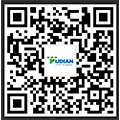The Application of Pid Controller AI-808
Abstract: This paper mainly introduces the application of AI-808 and frequency conversion technology in the modification of new catalyst production process in catalyst plant, and explains the calculation of optimal control and optimal control parameters. The system is running well and it is worth promoting.
Keywords: AI-808, variable frequency speed regulation, Double closed loop, Green design and manufacturing, Optimize control
1. Introduction
The production process of Qilu Petrochemical Catalyst Plant before the modification of the new catalyst production is: firstly, a certain amount of kaolin is put into the stirred tank from the conveying pipeline, and then put in some dispersing agent. After 2.2 hours of reaction, the other 7 kinds of materials are sequentially added. For the materials, there are problems as below: (1) Due to the long reaction time, the production efficiency of the product is seriously affected. (2) Due to the backwardness of the measuring equipment, the input dose is not well controlled, the production cost is greatly increased, the waste is generated, the investment is too small, the product quality is affected, and the product failure rate is increased. (3) Due to the special chemical nature of the materials, corrosive and dust pollution is serious, which seriously affects the health of workers.
In recent years, the degree of automation of industrial processes has become higher and higher, and people's awareness of environmental protection has increased. The frequency conversion regulation technology has been widely used at home and abroad for its excellent performance, especially after China's accession to the WTO, the competition in the petrochemical industry is even more competitive. Increasingly intense, and put forward higher requirements for the quality of products. In response to the problems in the original production process, the relevant leaders decided to modify the catalyst production process, retaining the other seven storage tanks unchanged, mainly to reform the kaolin, aluminite and dispersant. The transformation plan is: 1) 2 sets of kaolin pulping and reserve; (2) 1 set of aluminum stone beating and reserve; (3) 1 set of dispersing agent beating and reserve. The paper focuses on the application of double closed loop control and green design for variable frequency speed regulation.
2. The composition and working principle of the speed control unit
The frequency conversion speed control unit is mainly composed of DCS, PLC, batching belt scale, star feeder, frequency converter, AI-808 controller, flow meter and electric switching valve.
2.1 speed control unit works
The variable frequency speed control loop constitutes a double closed loop circuit. The first closed loop circuit is mainly composed of an electronic belt scale, a computer totalizer, a frequency converter, an AI-808 controller, a star feeder and a belt conveyor . The frequency converter selects Delta VFD015A43B, which is mainly used to control the feeding of star feeder. The batching belt scale detects the material flowing through the conveyor and transmits the signal to the computer totalizer. The computer totalizer sends signal of 4~20mA. The analog signal is sent to the controller. The controller sends two 4~20mA analog signals to the DCS system and multiplied by the coefficient K as the target value of the second closed loop. The other is transmitted to the inverter. The controller adjusts the V/F value of the frequency converter to adjust the speed of the star feeder, so as to ensure that the kaolin flowing through the belt conveyor is relatively uniform, in order to produce a more stable and accurate flow; the second closed loop control is adjusting the amount of the dispersant according to the amount of the first pass, so that the amount of the dispersant changes according to the amount of kaolin, on the one hand, ensuring the normal operation of the regulating valve, and on the other hand, ensuring that the kaolin and the dispersing agent are mixed in a certain ratio to ensure The accuracy of the ratio ensures the quality of the mixture and improves the reliability of the system.
2.2 AI-808 controller
Features of AI-808 controller: Domestically advanced instrument, is designed wih internal high-performance ASIC chip and modular hardware design, digital correction technology to eliminate the poor stability. The error caused by the resistor; the application of the auto-zero technology can be used for a long time without zero drift, and the measurement number is accurate and stable; it has various input and output specifications and alarm mode settings. It not only has manual/automatic bumpless switching operation function, but also has manual auto-tuning and display output value, and is used as a proportional output of the servo amplifier to directly control the valve position. The power supply can fluctuate within a wide range of 85-264VAC (50-60HZ). In the strong interference environment, the measurement accuracy and the stability of the work can be guaranteed.
At present, there are many manufacturers of controllers at home and abroad. We choose AI-808 controllers from Xiamen Yudian Company after comparing their performance. Mainly based on the following reasons: (1) high cost performance; (2) High Reliability and stability; (3) Good after-sales service. Practice has also proved that our original choice is correct.
2.3 Optimal control coefficient calculation and setting
The production is a complex dynamic process, and a certain point in the production process seems to be uncontrollable, resulting in passive production or increased labor intensity. The optimal control not only needs to optimize the production process when it is relatively static, but also needs to automatically optimize from one working condition to another, that is, to achieve dynamic optimal control. The so-called dynamic optimal control is to find a parameter or a set of parameters, so that the functions of the target parameter is optimal under the constraint condition.
In order to achieve optimal control, the key is to determine the appropriate control coefficient, then how to calculate and set the control coefficient of the PID controller?
In the automatic control system, the flow rate should first be converted into a unified standard signal of measurement, and the relationship between the signals should be established. In the system, the flow signal is uniformly converted into a standard current signal, that is, 4-20 mA analog current which is proportional to the flow rate. Therefore, it is obvious that the ratio K of the production process should be converted into the ratio coefficient K' inside the DCS to set the ratio.
I1=Q1/Q1max×I (1)
I2=Q2/Q2max×I (2)
Where: I1 is the current corresponding to the kaolin flow; I2 is the current corresponding to the dispersant flow
Q1 is the flow rate corresponding to kaolin; Q2 is the flow rate corresponding to the dispersant
Q1max is the maximum flow rate set by kaolin; Q2max is the maximum flow set by the dispersant
I is the standard current signal (20mADC)
Set: K'= I1'/I1 (3)
K' is the control coefficient of the comparator. To achieve optimal control of the system, that is, the system is in dynamic equilibrium, so
I1'=I2 (4)
Also set: K=Q2/Q1 (5)
K is the ratio required by the production process and can be obtained from (1) to (5):
K'=K×Q1max/Q2max (6)
It can be seen from equation (6) that K' is related to the set range value of the measuring instrument, and is independent of the size of the production loads Q1 and Q2. Secondly, the control coefficient is determined according to the situation in the production process. For example, the transport capacity of kaolin in the system is 6t/h, and the transport amount of dispersant is 1.2t/h. Available: K' = K×1.2 / 6 = K / 5 = 0.2K. When K=0.2, K'=0.04; when K=0.5, K'=0.1; when K=1, K'=0.2, K' value is according to the production process, through the upper computer to the DCS system inside 2 #PID to set.
2.4 Control trend curve
In order to achieve the purpose of system process modification, the dispersant must be required to follow the change of kaolin well, and the amount of kaolin can be stabilized within a certain range. Although there are many influencing factors on the site, through the close cooperation of the majority of personnel, the system is successfully debugged.
3. Green design and manufacturing Green design and manufacturing is the only way for human sustainable development. It links the ecological environment and economic society into a coordinated and integrated organic whole. It requires economic development to consider the long-term carrying capacity of the natural ecological environment and meet the long-term human needs. The need to generate.
In the technological transformation of the system, from the design of the system to the generation of products, including the turnover, recycling and waste in the production process, the new ideas of green design are fully utilized. For example, when designing the system design, the new idea of green design is placed in the first place. Under the premise of satisfying the production process and ensuring the quality of the product, the green design is adopted as much as possible; when the production process is ensured, the product quality is guaranteed, and the green design is adopted. In times of conflict, a policy of capital tilt is adopted to meet actual needs. In the system design stage, measures that affect environmental factors and prevent pollution are incorporated into product design, taking environmental performance as the target and starting point of product design, minimizing production pollution to the environment, fundamentally preventing pollution and saving energy. And resources. In the design, HONEYWELL's DCS distributed control system and variable frequency speed control technology are adopted, which truly reflects the humanized design, fully realizes the automation of the production process, greatly reduces labor intensity, improves production efficiency, reduces noise pollution, saves energy and reduces impact on the power grid. . In the process of logistics, the material is completely sealed, thereby preventing the pollution of the surrounding environment by powdery and granular materials (such as aluminum stone, kaolin, etc.) and protecting the health of workers. Improve the competitiveness of the enterprise market and sustainable development capabilities.
4. Problems and solutions in process transformation 4. Problems with the data collected by 1DCS and solutions
Since DCS mainly collects 4~20mA analog current signals, the analog current has its own defects, especially the 4~20m flow signal collected by the regulator is more error caused by the transmission, and at the same time, because the regulator uses 2 channels 4~ The 20 mA module has a serious interference with each other, and the signal transmitted to the DCS is clearly missing. Later, the design was considered. Through experimentation, it was found that there are two ways to solve it: First, replace the 4~20mA module inside the PID, use the photoelectric isolation module, and handle the grounding of the system. Second: directly collect the analog signal of the computer totalizer, but there is only one interface of the totalizer, and then the analog output of the totalizer is modified to accurately send a 4-20 mA analog interface to the regulator at the same time. DCS not only ensures the normal adjustment of the regulator, but also satisfies the DCS to accurately collect the material flowing through the conveyor.
4, 2 control valve change frequency too fast
During the adjustment process of the regulator, the system has a serious overshoot phenomenon, the system oscillation is more serious, the star feeder keeps turning when it stops, the frequency of the regulating valve changes too fast, it can not work normally, and it is easy to be damaged. The main reason is that the silo cannot be uniformly unloaded, the on-site vibration phenomenon is serious, and the internal parameters of the accumulator and the regulator are not properly set. Exclude one by one according to the site conditions to ensure that the regulating valve works normally.
Implementation of 4, 3 inverter control scheme
Due to the original production process, the two silos are fed to the conveyor (built-in electronic belt scale), which requires two star feeders for feeding. After many aspects of demonstration and production process requirements, two inverters are used. The device is controlled, but only one 4 to 20 analog signals are provided, and the inverter switch is used at the same time, and one or two of them are all selected according to the production needs.
5, the current application effect Through nearly four years of trial operation, the use of better results, the specific performance in the following aspects:
5, 1 production efficiency is greatly improved
In the original production process, the reaction time of kaolin and dispersant was about 2.2 hours, and the reaction time of the mixture after the reaction with the other seven materials was 40 minutes. It can be seen that the production efficiency of the production process after the reforming was increased by 4 times.
5, 2 system reliability is greatly improved
Since the system adopts the DCS distributed control system, PLC, frequency converter, and electric switching valve are all imported devices, and after strict screening, the system has been running stably for several months.
5, 3 green design and humanized design are fully reflected
After entering the 21st century, with the improvement of living standards, people's awareness of environmental protection has been significantly enhanced, and green design technology is rapidly being applied in various industries as a new topic. It is precisely because the system makes full use of the advanced idea of green design that the system has been put into operation and achieved many unexpected effects beforehand.
5, 4 product quality and qualified rate significantly improved
According to the needs of the production process, after the parameters are set by the DCS system, the production process is strictly controlled automatically, which avoids the interference of human factors, thereby greatly improving the quality and the pass rate of the products.
5, 5 process control is stable and stable
Double closed-loop control is adopted in the system, and the system parameters are optimally calculated. The analog current signal input into the DCS system (ie, the target value of the second closed-loop control) is basically a stable signal. It is clearly seen from Figure 3. The system control accuracy is within ±1% and can work smoothly.
5, 6 energy saving effect is remarkable
There are 6 motors for frequency conversion adjustment of kaolin and aluminite in the system, the power is 1.5kw, and the power is 9kw in all working. In actual work, the power only reaches 55~65%, saving a lot of energy.
6. Conclusion The system has been successfully operated in Qilu Petrochemical for nearly 4 years since July 2002. It is reliable in operation, convenient in operation, and has strong anti-interference ability, which greatly improves the production efficiency of the enterprise and is highly praised by the leaders of Qilu Petrochemical Company. It has also become a model project of our company. On the one hand, it is reasonable in design and device selection, and the user has good application to the equipment. On the other hand, it is inseparable from the reliable quality of the AI-808 regulator.



